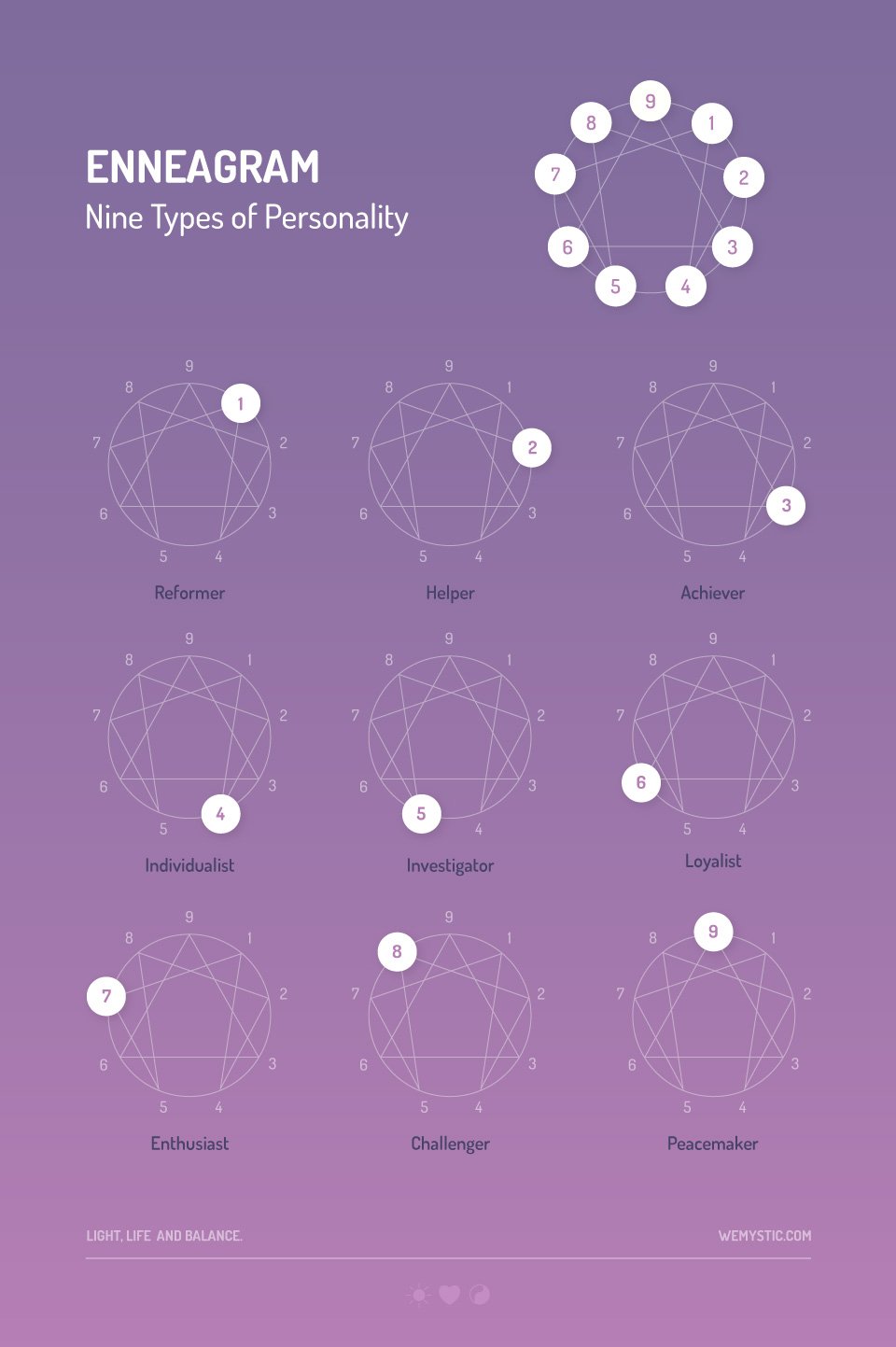Enneagram personality test: which one is your type?

There are many online enneagram personality tests that consist of answering a series of questions to classify a person’s personality type, using this famous symbol of knowledge. The enneagram personality test can describe nine types of personalities that fit into behavioral patterns. The personalities are mapped on the nine points of the enneagram and the relationship that may exist between them.
The History of Enneagram
The name Enneagram comes from the Greek: Ennea is the Greek word that means nine and Gramma means something drawn or written. The origin of this knowledge is not known exactly, but it is believed that it was born in Babylon about 4,500 years ago, although there are versions that claim it was born in Greece about 2,500 years ago.
This creation is also attributed to the Jewish Kabbalah, Christian mysticism and Sufism, a mystical form of Islam. In Dante’s Divine Comedy, the characters correspond to the human types defined in the enneagram.
The drawing is attributed to George Gurdjieff, Armenian mystic and spiritual dance teacher who in 1930 developed the Enneagram of the fourth path, which was little spread in his time, but which became more popular in the United States in the 60s.
What is the enneagram?
The Enneagram is a personality writing system that describes patterns of how people conceptualize the world and manage their emotions. The Enneagram model describes nine different personality types and maps each of these types in a nine-pointed diagram that helps illustrate how the types relate to each other.
According to the Enneagram, each personality has a certain worldview and looks at the world through their own lens or filter. This allows us to explain why people behave in a certain way.
The Enneagram shows possibilities for personal development and provides a basis for the understanding of others by describing how the basic personality adapts, supports and responds to stressful situations.
This system has been the inspiration for multiple personality tests, as well as for books on an eclectic variety of topics, from personal development and spiritual growth, to personal and professional relationships.
Enneagram personality test: Understanding the enneagram
The base of the Enneagram is a nine-pointed geometric symbol. It consists of an external circle, in which the nine points (personalities) are numbered clockwise and evenly spaced.
There is also a triangle between points 9, 3 and 6 and an irregular hexagon that connects the other points. The circle represents the totality and unity of human life, while the other forms represent how it is divided.
Each basic type in the Enneagram is also connected by two lines to two other basic types; for example, Type 1 is connected to Type 7 and Type 4. The first line is connected to the type that the person has left or repressed in childhood; the characteristics of this type must be reintegrated for the person to develop.
The second line connects with the type in which the person can grow once they are ready to reach a higher stage of development.
These connection lines highlight how each basic type has indispensable strengths, but at the same time it has darker sides that are full of challenges. The inclusion of these lines moves the Enneagram from a purely descriptive personality model to a dynamic one, which shows how personality can change under different conditions.
In the enneagram personality tests hundreds of questions are asked to determine the type of personality you have.
Personality types in the Enneagram personality test
We present the nine personality types with their respective basic characteristics, which you can find in the personality tests of the enneagram that you can perform online.
Type 1 – The Perfectionist / The Reformer
Obsession: organization.
Motivation: to be correct.
Defect: anger.
Sacred idea: perfection.
Compulsion: perfectionism/criticism.
Type 2 – The Helper / The manipulator
Obsession: others.
Motivation: to be loved.
Defect: pride.
Sacred idea: the will.
Compulsion: self-deception.
Type 3 – The Achiever / The Competitive
Obsession: successful and competitive self-image.
Motivation: to be admired.
Defect: vanity.
Sacred idea: harmony.
Compulsion: the lie.
Type 4 – The Individualist / The Romantic
Obsession: the shapes.
Motivation: to be different.
Defect: envy.
Sacred idea: to know the origin.
Compulsion: dissatisfaction.
Type 5 – The Investigator / The Thinker
Your motivation & obsession: to have knowledge.
Defect: greed.
Sacred idea: omniscience.
Compulsion: isolation.
Type 6 – The Loyalist / “The Devil’s Advocate”
Obsession: authority.
Motivation: to be sure.
Defect: fear.
Sacred idea: strength.
Compulsion: doubt.
Type 7 – The Enthusiast / The Impulsive
Obsession: the word.
Motivation: have satisfaction.
Defect: gluttony.
Sacred idea: wisdom.
Compulsion: quackery.
Type 8 – The Challenger / The Leader
Obsession: justice.
Motivation: to be respected.
Defect: lust.
Sacred idea: the truth.
Compulsion: revenge.
Type 9 – The Peacemaker / The Conservative
Obsession: the body.
Motivation: to be calm.
Defect: laziness.
Sacred idea: unity.
Compulsion: indolence / apathy.


